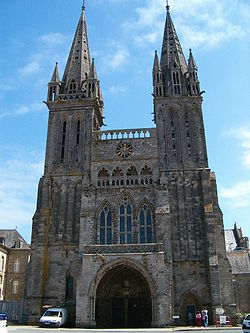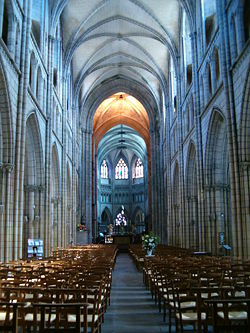
Saint-Pol-de-Léon Cathedral
Encyclopedia

Saint-Pol-de-Léon
Saint-Pol-de-Léon is a commune in the Finistère department in Bretange in northwestern France, located on the coast.It is famous for its 13th-century cathedral on the site of the original founded by Saint Paul Aurelian in the 6th century. It has kept a unique architecture, such as Notre-Dame du...
in Brittany
Brittany
Brittany is a cultural and administrative region in the north-west of France. Previously a kingdom and then a duchy, Brittany was united to the Kingdom of France in 1532 as a province. Brittany has also been referred to as Less, Lesser or Little Britain...
.
It was formerly the seat of the Bishop of Saint-Pol-de-Léon, a bishopric established in the 6th century and abolished under the Concordat of 1801
Concordat of 1801
The Concordat of 1801 was an agreement between Napoleon and Pope Pius VII, signed on 15 July 1801. It solidified the Roman Catholic Church as the majority church of France and brought back most of its civil status....
, when its territory was transferred to the Diocese of Quimper. Since 1901, the cathedral also is "Basilique Mineure de l'Annonciation".
It is dedicated to its 6th century founder, the first bishop
Bishop
A bishop is an ordained or consecrated member of the Christian clergy who is generally entrusted with a position of authority and oversight. Within the Catholic Church, Eastern Orthodox, Oriental Orthodox Churches, in the Assyrian Church of the East, in the Independent Catholic Churches, and in the...
Saint Paul Aurelian. The present building however, although on the same site, was built in the 13th century (with later additions).
Built on the site of an ancient Roman
Roman Empire
The Roman Empire was the post-Republican period of the ancient Roman civilization, characterised by an autocratic form of government and large territorial holdings in Europe and around the Mediterranean....
church, some vestiges of which still exist. This great monument has been constructed in several stages. The facade with its two high towers and the nave
Nave
In Romanesque and Gothic Christian abbey, cathedral basilica and church architecture, the nave is the central approach to the high altar, the main body of the church. "Nave" was probably suggested by the keel shape of its vaulting...
made of stone of Caen
Caen
Caen is a commune in northwestern France. It is the prefecture of the Calvados department and the capital of the Basse-Normandie region. It is located inland from the English Channel....
, limestone demonstrate this stylistic and economical heritage from Normandy. The western façade and the south porch
Porch
A porch is external to the walls of the main building proper, but may be enclosed by screen, latticework, broad windows, or other light frame walls extending from the main structure.There are various styles of porches, all of which depend on the architectural tradition of its location...
date back from the 13th century whereas the chancel
Chancel
In church architecture, the chancel is the space around the altar in the sanctuary at the liturgical east end of a traditional Christian church building...
and the transept
Transept
For the periodical go to The Transept.A transept is a transverse section, of any building, which lies across the main body of the building. In Christian churches, a transept is an area set crosswise to the nave in a cruciform building in Romanesque and Gothic Christian church architecture...
are from the beginning of the 15th century. The cathedral was completed in the second half of the 16th century (the ambulatory
Ambulatory
The ambulatory is the covered passage around a cloister. The term is sometimes applied to the procession way around the east end of a cathedral or large church and behind the high altar....
and the southern chapel
Chapel
A chapel is a building used by Christians as a place of fellowship and worship. It may be part of a larger structure or complex, such as a church, college, hospital, palace, prison or funeral home, located on board a military or commercial ship, or it may be an entirely free-standing building,...
).
Brief overview of distinctive features

- The great organOrgan (music)The organ , is a keyboard instrument of one or more divisions, each played with its own keyboard operated either with the hands or with the feet. The organ is a relatively old musical instrument in the Western musical tradition, dating from the time of Ctesibius of Alexandria who is credited with...
in the cathedral built between 1657 and 1660 by the English refugees Robert and Thomas Dallam. It is composed of 2118 pipes and it is listed. - The 16th century oakOakAn oak is a tree or shrub in the genus Quercus , of which about 600 species exist. "Oak" may also appear in the names of species in related genera, notably Lithocarpus...
stallStallIn fluid dynamics, a stall is a reduction in the lift coefficient generated by a foil as angle of attack increases. This occurs when the critical angle of attack of the foil is exceeded...
. - The relicRelicIn religion, a relic is a part of the body of a saint or a venerated person, or else another type of ancient religious object, carefully preserved for purposes of veneration or as a tangible memorial...
s, amongst them Paul Aurélien Celtic bell, one of the oldest Carolingian bell in Brittany and, in a crystal tube, a thorn from the Christ crown. - 32 boxes containing skullSkullThe skull is a bony structure in the head of many animals that supports the structures of the face and forms a cavity for the brain.The skull is composed of two parts: the cranium and the mandible. A skull without a mandible is only a cranium. Animals that have skulls are called craniates...
s, a reminder of the custom in use until the 19th century, which consisted in exhuming the skeletons after five years in order to make room to the new deceased. The bones were carefully laid down in the charnel house and the skulls were locked up in small pierced boxes and they were then handed over to the families. - The stone (tombTombA tomb is a repository for the remains of the dead. It is generally any structurally enclosed interment space or burial chamber, of varying sizes...
) of Marie-Amice Picard, where is buried one of the most extraordinary figures of the history of mysticismMysticismMysticism is the knowledge of, and especially the personal experience of, states of consciousness, i.e. levels of being, beyond normal human perception, including experience and even communion with a supreme being.-Classical origins:...
. She died in 1652, and in her days, she has attracted the attention of the greatest European minds. She remained 17 years without taking any food, she suffered the martyrdom of the Saint of the day. - A roman sarcophagusSarcophagusA sarcophagus is a funeral receptacle for a corpse, most commonly carved or cut from stone. The word "sarcophagus" comes from the Greek σαρξ sarx meaning "flesh", and φαγειν phagein meaning "to eat", hence sarkophagus means "flesh-eating"; from the phrase lithos sarkophagos...
which is thought to be the sepulture of Conan Mériadec, first Christian king of Brittany, who died in 421. - The ciboriumCiboriumthumb|250px|[[Silver-gilt]] ciboriumA ciborium is a vessel, normally in metal...
containing the Holy EucharistEucharistThe Eucharist , also called Holy Communion, the Sacrament of the Altar, the Blessed Sacrament, the Lord's Supper, and other names, is a Christian sacrament or ordinance...
. It is located above the former high altar, it has the shape of a palm tree symbolizing the eternity and the resurrection. There are three similar ciboriums in France(in AmiensAmiensAmiens is a city and commune in northern France, north of Paris and south-west of Lille. It is the capital of the Somme department in Picardy...
, ReimsReimsReims , a city in the Champagne-Ardenne region of France, lies east-northeast of Paris. Founded by the Gauls, it became a major city during the period of the Roman Empire....
and Saint-GermainSaint-Germain- People :* Saint Germain of Paris , bishop of Paris who founded Saint-Germain-des-Prés* Germanus of Auxerre - People :* Saint Germain of Paris (496–576), bishop of Paris who founded Saint-Germain-des-Prés* Germanus of Auxerre - People :* Saint Germain of Paris (496–576), bishop of Paris who...
).

